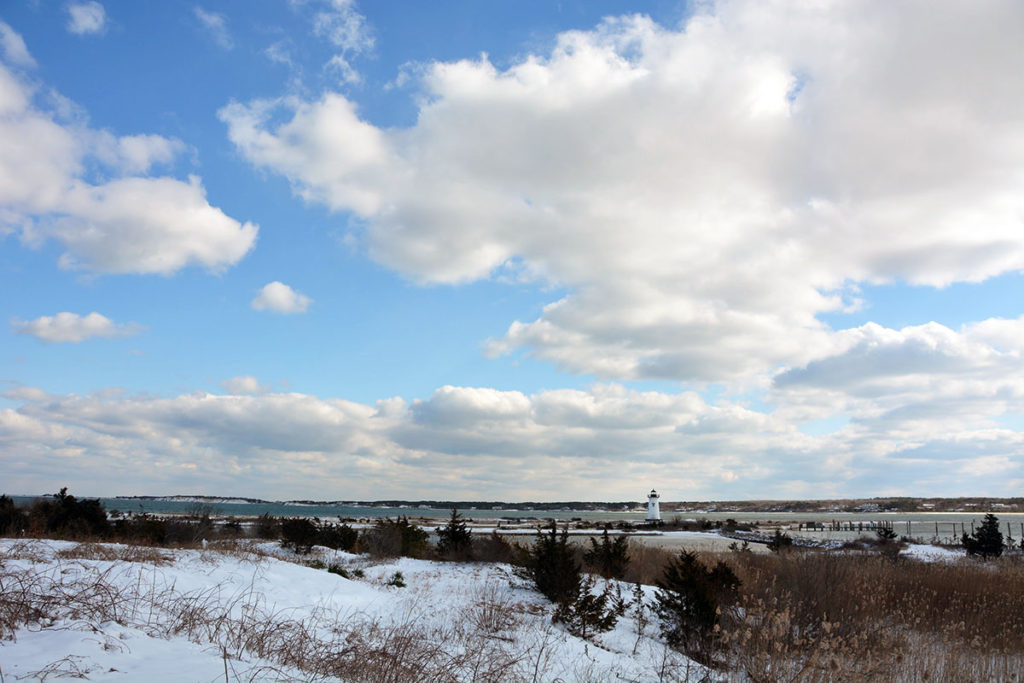
Edgartown Harbor
Lighthouse Beach & the Harbor Wetlands
Conservation History: Legal Filings and Furtive Fillings
Lighthouse Beach as we know it today is a rather recent creation, involving both Mother Nature and the hard work of her most successful invasive species. The lighthouse, originally built in 1828 (and replaced after the 1938 Hurricane, more detail below), was a lone beacon surrounded by water, accessed via a long elevated boardwalk. But over time, the coastal current deposited sediment around Little Beach, eventually filling the area around the lighthouse and creating a small tidal salt marsh.
Never ones to miss a golden opportunity, business partners Bob Carroll and State Senator Allen Jones, then-owners of the Harbor View Hotel, as well as 3 acres of this newly created real estate, proposed filling a portion of the wetland to accommodate the construction of two new houses and a tennis court.
On July 27, 1974, Governor Francis Sargent signed legislation creating a regional planning agency, the Martha’s Vineyard Commission. The MVC held its first meeting on December 5, 1974.
In May, 1976, less than a year-and-a-half following the creation of the MVC, the developers approached the town selectmen for endorsement of the project. Like a microcosm of state vs federal clashes nationally, the action set the stage for a Vineyard constitutional crisis of sorts between local and regional authority.
Today, at the first indication that a proposal is a Development of Regional Impact (DRI), all local approval action ceases. Clocks for deadlines “toll,” and a local board referral is made to the MVC to take action prior to any permit granting by the town. However, in this early challenge to our regional planning agency’s authority, the building permits were signed in Edgartown. But, because the permits still needed to be reviewed by another local entity, the Planning Board, they were not immediately delivered to the developers. It was there that the anti-MVC ranks were broken. Recognizing the regional nature of the proposal, the Planning Board courageously referred it to the Commission. The MVC disapproved the subdivision plan, ruling that the benefits failed to outweigh the detriments – including the fact that it would cause irreversible environmental damage.
Foreshadowing the hardball tactics to come, Carroll and Jones did not bother to appeal the MVC’s decision, choosing instead to simply ignore it. With a political wave building to withdraw the town from the Commission, the developers sought permits from the state’s wetlands protection authorities to fill the salt marsh and develop the site. A year and a half later, Edgartown indeed left the MVC following a referendum vote. Then in 1979, the state wetland authorities ruled that the project could proceed.
Immediately, work began to fill one quarter acre of wetlands with 6,500 cubic yards of land fill. Soon thereafter, the federal Army Corps of Engineers issued a cease-and-desist order under the Clean Water Act, requiring the developers to secure permission to deposit additional fill, or even to allow the fill they had already placed to remain. The developers were reminded that the Corps had sent a letter some months earlier explaining the federal requirements. Carroll and Jones’ response was to say they didn’t get the letter.
The subsequent hearing on the permit requested from the Army Corps revealed public outrage over the project. Weighing in on one side were testimony from VCS and colleagues, 259 letters of objection, and a petition containing hundreds of signatures. A single letter in support was also received.
Despite this, the Army Corps of Engineers issued the dredge and fill permit in 1981. So, onward it went to federal court, where VCS submitted an amicus (“friend of the court”) brief in support of environmental protection of the wetland. In 1982, the court sided with the environment, ruling that the Army Corps failed to comply with EPA guidelines (and its own regulations), and failed to demonstrate that there were no feasible alternatives to the proposed project. The court also ruled that defendants violated the National Historic Preservation Act by failing to include the Edgartown lighthouse in their assessment of the proposed project’s impacts on historic values. But the case was not truly settled; the federal court instead remanded the matter to the Army Corps for further review.
Two years later, town benefactor Fairleigh Dickinson, Jr. made possible a compromise solution: the wetlands and view of the harbor were conserved, with the developers receiving another property in town as part of a swap. To their credit, they then conveyed that land to the Edgartown Council on Aging, where it would become a center for elderly programs named “The Anchors.”
Edgartown Lighthouse History
The original Edgartown lighthouse dates to 1828, but the structure sustained massive damage in the 1938 Hurricane and was torn down the following year by the U.S. Coast Guard. It was never rebuilt, strictly speaking. Rather, it was replaced by dismantling the Ipswich Range Light (from Crane Beach, north of Boston), and sending it by barge all the way to Edgartown Harbor.
That 45-foot cast-iron structure was originally built in 1881. It was refurbished in 1985 by the Coast Guard, and in 1990, solar-powered plastic optics were installed. The lease of the tower was transferred to the Dukes County Historical Society (today the MV Museum) in 1994, and a children’s memorial was established there in 2001.
Top image from our 2016 Winter Walk at the Edgartown Harbor, click here for more
